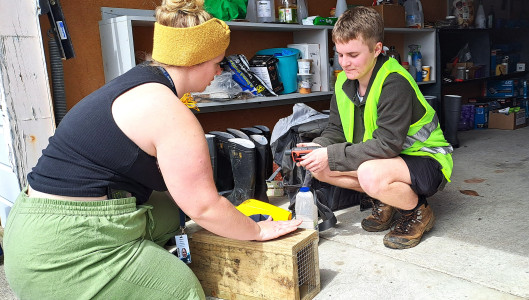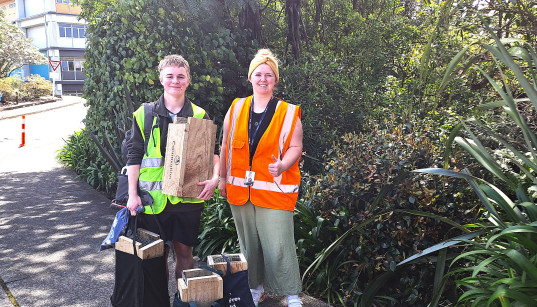WITT student protecting nature on campus
WITT is lucky enough to be surrounded by beautiful gardens and bush frequented by tūi, kererū, pīwakawaka, and lizards - like the rare gold-striped gecko. But with this come some unwanted pests.
Curtis Stewart, who is enrolled in the Diploma in Environmental Management (Level 5) wanted to help and as part of his assessment work was given the opportunity to launch a brand-new rat trapping project right on his study space doorstep on campus.

Caption: Curtis with tutor Georgina preparing bait and trap settings.
After researching different types of traps and identifying which ones are best suited to specific terrain and urban contexts, he installed traps in 10 locations around campus. He’s targeting areas where rats like to hang out – including bush and rubbish bins.
With the help of fellow students, Curtis will regularly check the traps and bait them with peanut butter (a rat favourite) to learn about which traps are more effective and keep track of how many rats are caught. Data will go into Trap.NZ - a free service used throughout Aotearoa for recording and monitoring traps and bait stations and collecting biodiversity data.
Conservation tutor Georgina Ngametua, says; “The best part about the project is that not only does it provide Curtis with a meaningful project, but it also supports our native environment, protects WITT from pests, and provides a learning resource for future students who will get to practise trapping in a fully accessible way.”
Nature’s call
Curtis decided to study conservation at WITT, having learned about pest control in primary school. “I liked being able to do work outside with my hands and I found the Certificate in Conservation (Level 4) course at one of WITT's open days.”
He hopes his knowledge and skills from the Level 5 programme will help him secure a job with the Department of Conservation or a local council.
With just a few weeks left before he finishes, his next steps are checking the traps weekly.
“My data collection will be put into a graph comparing the number of rats/mice caught in the different types of traps and then presenting that data to my class at the end of the semester.”
What he enjoys about the course is “the flexibility of having all the work online, which allows me to complete it anywhere. We come together one day a week [in class] and learn about the flora and fauna we have in New Zealand.”

Caption: Curtis and Georgina, ready to place traps in the bush.
His tutor, Georgina Ngametua, has been teaching at WITT for three years and is passionate about her role introducing the next generation to the rewards and excitement of working in the natural environment.
“We have awesome courses for people who like to be outside in nature and want to make positive impact,” she says. “We get outdoors for some epic learning experiences, often in partnerships with local organisations – for example kiwi monitoring and building tracks with DOC (Department of Conservation), water sampling with TRC (Taranaki Regional Council), and track clearing at Rotokare (a pest-free scenic reserve near Eltham).”
She hopes Curtis’ campus work will “pave the way for future student projects, so that predator trapping around campus can continue to offer valuable learning opportunities while offering awesome benefits to WITT and our native species.”
For more information on studying conservation and environmental courses at WITT: